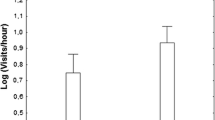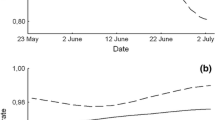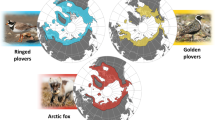Abstract
Often in colonial seabirds, all colony members are believed to defend against nest predators and experience equal nest predation risk. However, the variation of defense behavior among members and its reproductive consequences are largely unknown. We investigated (1) individual variation in the nest defense of breeding Black-tailed Gulls Larus crassirostris against a natural egg predator, the Jungle Crow Corvus macrorhynchos and (2) how this behavioral variation affects an individual’s own nest predation risk and that of their neighbors. Results were compared between 2 years where crow attack levels were manipulated to average 5 and 22 times normal rates (“low” and “high” predation risk years, respectively) by the placement of varying numbers of artificial nests containing unguarded eggs at the perimeter of the gull colony. In both years, 23–38% of parents, mostly males, showed “aggressive” defense behavior (strikes or chases) against crows and decoys. Other “non-aggressive” gulls showed no defense. In the year of low predation risk, intrusion rates by crows (landing within 0.5 m of an individual gull’s nest) were similar for aggressive and non-aggressive gulls. In the year of high predation risk, however, the rates of intrusion for aggressive gulls (4%) and for non-aggressive gulls with an aggressive neighbor (37%) were significantly lower than for non-aggressive gulls without an aggressive neighbor (76%). These results indicate that aggressive individuals reduce nest predation risk for themselves and conspecific neighbors in a colonially breeding species.




Similar content being viewed by others
References
Alonso-Alvarez C, Velando A (2001) Effect of testosterone on the behaviour of Yellow-legged Gulls Larus cachinnans in a high-density colony during the courtship period. Ethol Ecol Evol 13:341–349
Arlet ME, Isbell LA (2009) Variation in behavioral and hormonal responses of adult male gray-cheeked mangabeys (Lophocebus albigena) to crowned eagles (Stephanoaetus coronatus) in Kibale National Park, Uganda. Behav Ecol Sociobiol 63:491–499
Brown CR, Brown MB (2001) Avian coloniality: progress and problem. In: Nolan V Jr, Thompson CF (eds) Current ornithology vol. 16. Plenum Press, New York, pp 1–82
Brunton DH (1997) Impact of predators: center nests are less successful than edge nests in a large nesting colony of Least Terns. Condor 99:372–380
Bukaciñski D, Bukaciñska M, Lubjuhn T (2000) Adoption of chicks and the level of relatedness in common gull, Larus canus, colonies: DNA fingerprinting analyses. Anim Behav 59:289–299
Burger J, Gochfeld M (1991) The common tern. Columbia University Press, New York
Caro T (2005) Antipredator defenses in birds and mammals. The University of Chicago Press, Chicago & London
Carter AJ, Pays O, Goldizen AW (2009) Individual variation in the relationship between vigilance and group size in eastern grey kangaroos. Behav Ecol Sociobiol 64:237–245
Chochi M, Niizuma Y, Takagi M (2002) Sexual differences in the external measurements of Black-tailed Gulls breeding on Rishiri Island, Japan. Ornith Sci 1:163–166
Clode D (1993) Colonially breeding seabirds: predators or prey? Trends Ecol Evol 8:336–338
Cockrem JF, Silverin B (2002) Variation within and between birds in corticosterone responses of great tits (Parus major). Gen Comp Endocrinol 125:197–206
Coulson JC (2002) Colonial breeding in seabirds. In: Schreiber EA, Burger J (eds) Biology of marine birds. CRC Press, New York, pp 87–113
Dingemanse NJ, Both C, Drent PJ, Tinbergen JM (2004) Fitness consequences of avian personalities in a fluctuating environment. Proc R Soc Lond Ser B-Biol Sci 271:847–852
Drent PJ, van Oers K, van Noordwijk AJ (2003) Realized heritability of personalities in the great tit (Parus major). Proc R Soc Lond Ser B-Biol Sci 270:45–51
Dugatkin LA, Godin JGJ (1992) Prey approaching predators—a cost-benefit perspective. Ann Zool Fenn 29:233–252
Elgar MA (1989) Predator vigilance and group-size in mammals and birds—a critical-review of the empirical-evidence. Biol Rev 64:13–33
Forslund P (1993) Vigilance in relation to brood size and predator abundance in the barnacle goose, Branta leucopsis. Anim Behav 45:965–973
Friesen VL, Montevecchi WA, Gaston AJ, Barrett RT, Davidson WS (1996) Molecular evidence for kin groups in the absence of large-scale genetic differentiation in a migratory bird. Evolution 50:924–930
García-Borboroglu P, Yorio P (2004) Effects of microhabitat preferences on kelp gull Larus dominicanus breeding performance. J Avian Biol 35:162–169
Gilchrist HG, Gaston AJ, Smith JNM (1998) Wind and prey nest sites as foraging constraints on an avian predator, the Glaucous Gull. Ecology 79:2403–2414
Groothuis TGG, Carere C (2005) Avian personalities: characterization and epigenesis. Neurosci Biobehav Rev 29:137–150
Harris MP (1964) Aspect of the breeding biology of the gulls Larus argentatus, L. fuscus and L. marinus. Ibis 106:432–456
Helfenstein F, Tirard C, Danchin E, Wagner RH (2004) Low frequency of extra-pair paternity and high frequency of adoption in Black-legged Kittiwakes. Condor 106:149–155
Kazama K (2007) Factors affecting egg predation in Black-tailed Gulls. Ecol Res 22:613–618
Kazama K, Fukuda T, Mori T (2009) Adoption of additional chicks from other nests by the Black-tailed Gull, in relation to chick age. Jpn J Ornithol 58:103–107 (In Japanese with English abstract)
Knight RL, Temple SA (1986) Nest defense in the American goldfinch. Anim Behav 34:887–897
Koolhaas JM, Meerlo P, DeBoer SF, Strubbe JH, Bohus B (1997) The temporal dynamics of the stress response. Neurosci Biobehav Rev 21:775–782
Koolhaas JM, Korte SM, De Boer SF, Van Der Vegt BJ, Van Reenen CG, Hopster H, De Jong IC, Ruis MAW, Blokhuis HJ (1999) Coping styles in animals: current status in behavior and stress-physiology. Neurosci Biobehav Rev 23:925–935
Kosugi K, Sugimura N, Sato M (2005) Breeding colony status of Black-tailed Gull in Rishiri Island, northern Hokkaido (1) Estimated population from 2002–2004. Rishiri Kenkyu 24:29–35 (In Japanese with English abstract)
Kralj-Fiser S, Scheiber IBR, Blejec A, Moestl E, Kotrschal K (2007) Individualities in a flock of free-roaming greylag geese: behavioral and physiological consistency over time and across situations. Horm Behav 51:239–248
Krause J, Ruxton GD (2002) Living in groups. Oxford University Press, New York
Lambrechts MM, Prieur B, Caizergues A, Dehorter O, Galan M-J, Perret P (2000) Risk-taking restraints in a bird with reduced egg-hatching success. Proc R Soc Lond B 267:333–338
Mills JA (1994) Extra-pair copulations in the Red-billed Gull: females with high-quality, attentive males. Behaviour 128:41–64
Montevecchi WA (1979) Predator–prey interactions between Ravens and Kittiwakes. Z Tierpsychol 49:136–141
Montgomerie RD, Weatherhead PJ (1988) Risks and reward of nest defense by parent birds. Q Rev Biol 63:167–187
Pierotti R (1980) Spite and altruism in gulls. Am Nat 115:290–300
R Developmental Core Team (2005) R: A language and environment for statistical computing. R Foundation for Statistical Computing, Vienna, Austria. ISBN3-900051-07-0, URL http://www.R-project.org
Reid ML, Montgomerie RD (1985) Seasonal patterns of nest defence by Baird’s sandpipers. Can J Zool 63:2207–2211
Shealer DA, Spendelow JA, Hatfield JS, Nisbet ICT (2005) The adaptive significance of stealing in a marine bird and its relationship to parental quality. Behav Ecol 16:371–376
Sih A, Bell AM, Johnson JC, Ziemba RE (2004) Behavioral syndromes: an integrative overview. Q Rev Biol 79:241–277
Stenhouse IJ, Gilechrist HG, Montevecchi WA (2005) An experimental study examining the anti-predator behaviour of Sabine’s gulls Xema sabini during breeding. J Ethol 23:103–108
van Oers K, de Jong G, van Noordwijk AJ, Kempenaers B, Drent PJ (2005) Contribution of genetics to the study of animal personalities: a review of case studies. Behaviour 142:1185–1206
Velando A, Márquez JC (2002) Predation risk and nest-site selection in the Inca tern. Can J Zool 80:1117–1123
Wallin K (1987) Defense as parental care in Tawny Owls Strix aluco. Behaviour 102:213–210
Whittam RM, Leonard ML (1999) Predation and breeding success in roseate terns (Sterna dougallii). Can J Zool 77:851–856
Whittam RM, Leonard ML (2000) Characteristics of predators and offspring in fluence nest defense by Arctic and Common terns. Condor 102:301–306
Wittenberger JF, Hunt GL Jr (1985) The adaptive significance of coloniality in birds. In: Farner DS, King JR, Parkes KC (eds) Avian biology Vol. 8. Academic, New York, pp 1–78
Acknowledgments
We thank Y. Sakurai and A. Takahashi for helpful comments during the course of the study. Thanks are also due to N. Takahashi, H. Sahara, J. Kaji, K. Kosugi, M. Sato, R. Sato, K. Nakaya, and T. Nishijima for their support in the field. The Marine Biomedical Institute of Sapporo Medical University provided space and resources for the fieldwork in 2004. Hokkaido Souya subprefectural office gave us permission (no. 46, 47 in 2004 and no. 7-1, 7-2 in 2005) to work on Black-tailed Gulls and to cut back vegetation in the study areas at Rishiri Island. We are grateful to M. J. Dunn, Y. Suzuki, D. Lyons, editors, and anonymous referees for their very helpful comments and suggestions to improve the manuscript.
Author information
Authors and Affiliations
Corresponding author
Additional information
Communicated by C. Brown
Rights and permissions
About this article
Cite this article
Kazama, K., Watanuki, Y. Individual differences in nest defense in the colonial breeding Black-tailed Gulls. Behav Ecol Sociobiol 64, 1239–1246 (2010). https://doi.org/10.1007/s00265-010-0938-8
Received:
Revised:
Accepted:
Published:
Issue Date:
DOI: https://doi.org/10.1007/s00265-010-0938-8




